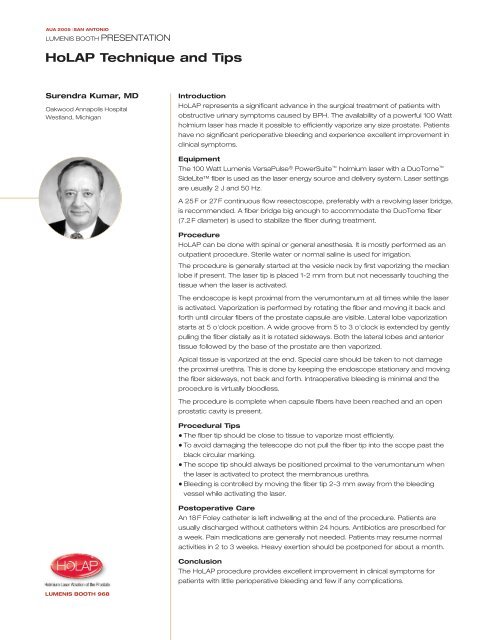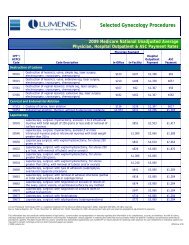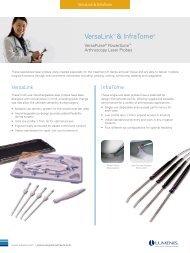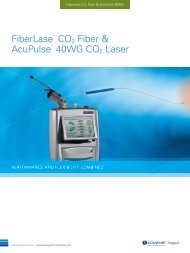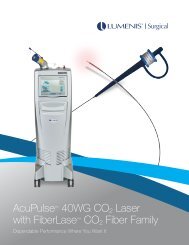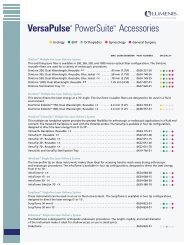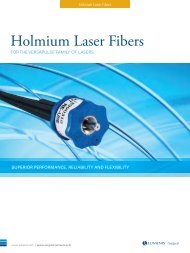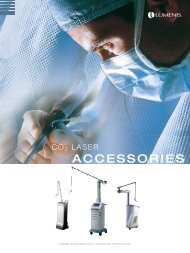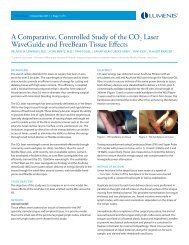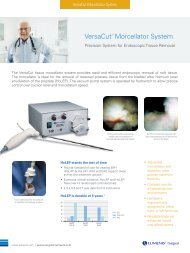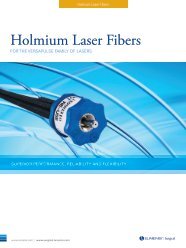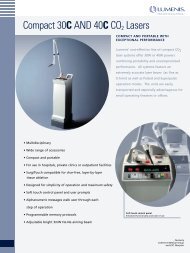HoLAP Technique and Tips - Lumenis Surgical
HoLAP Technique and Tips - Lumenis Surgical
HoLAP Technique and Tips - Lumenis Surgical
You also want an ePaper? Increase the reach of your titles
YUMPU automatically turns print PDFs into web optimized ePapers that Google loves.
AUA 2005 | SAN ANTONIO<br />
LUMENIS BOOTH PRESENTATION<br />
<strong>HoLAP</strong> <strong>Technique</strong> <strong>and</strong> <strong>Tips</strong><br />
Surendra Kumar, MD<br />
Oakwood Annapolis Hospital<br />
Westl<strong>and</strong>, Michigan<br />
Introduction<br />
<strong>HoLAP</strong> represents a significant advance in the surgical treatment of patients with<br />
obstructive urinary symptoms caused by BPH. The availability of a powerful 100 Watt<br />
holmium laser has made it possible to efficiently vaporize any size prostate. Patients<br />
have no significant perioperative bleeding <strong>and</strong> experience excellent improvement in<br />
clinical symptoms.<br />
Equipment<br />
The 100 Watt <strong>Lumenis</strong> VersaPulse ® PowerSuite holmium laser with a DuoTome <br />
SideLite fiber is used as the laser energy source <strong>and</strong> delivery system. Laser settings<br />
are usually 2 J <strong>and</strong> 50 Hz.<br />
A 25 F or 27 F continuous flow resectoscope, preferably with a revolving laser bridge,<br />
is recommended. A fiber bridge big enough to accommodate the DuoTome fiber<br />
(7.2 F diameter) is used to stabilize the fiber during treatment.<br />
Procedure<br />
<strong>HoLAP</strong> can be done with spinal or general anesthesia. It is mostly performed as an<br />
outpatient procedure. Sterile water or normal saline is used for irrigation.<br />
The procedure is generally started at the vesicle neck by first vaporizing the median<br />
lobe if present. The laser tip is placed 1-2 mm from but not necessarily touching the<br />
tissue when the laser is activated.<br />
The endoscope is kept proximal from the verumontanum at all times while the laser<br />
is activated. Vaporization is performed by rotating the fiber <strong>and</strong> moving it back <strong>and</strong><br />
forth until circular fibers of the prostate capsule are visible. Lateral lobe vaporization<br />
starts at 5 o'clock position. A wide groove from 5 to 3 o'clock is extended by gently<br />
pulling the fiber distally as it is rotated sideways. Both the lateral lobes <strong>and</strong> anterior<br />
tissue followed by the base of the prostate are then vaporized.<br />
Apical tissue is vaporized at the end. Special care should be taken to not damage<br />
the proximal urethra. This is done by keeping the endoscope stationary <strong>and</strong> moving<br />
the fiber sideways, not back <strong>and</strong> forth. Intraoperative bleeding is minimal <strong>and</strong> the<br />
procedure is virtually bloodless.<br />
The procedure is complete when capsule fibers have been reached <strong>and</strong> an open<br />
prostatic cavity is present.<br />
Procedural <strong>Tips</strong><br />
• The fiber tip should be close to tissue to vaporize most efficiently.<br />
• To avoid damaging the telescope do not pull the fiber tip into the scope past the<br />
black circular marking.<br />
• The scope tip should always be positioned proximal to the verumontanum when<br />
the laser is activated to protect the membranous urethra.<br />
• Bleeding is controlled by moving the fiber tip 2-3 mm away from the bleeding<br />
vessel while activating the laser.<br />
Postoperative Care<br />
An 18 F Foley catheter is left indwelling at the end of the procedure. Patients are<br />
usually discharged without catheters within 24 hours. Antibiotics are prescribed for<br />
a week. Pain medications are generally not needed. Patients may resume normal<br />
activities in 2 to 3 weeks. Heavy exertion should be postponed for about a month.<br />
Conclusion<br />
The <strong>HoLAP</strong> procedure provides excellent improvement in clinical symptoms for<br />
patients with little perioperative bleeding <strong>and</strong> few if any complications.<br />
LUMENIS BOOTH 968


